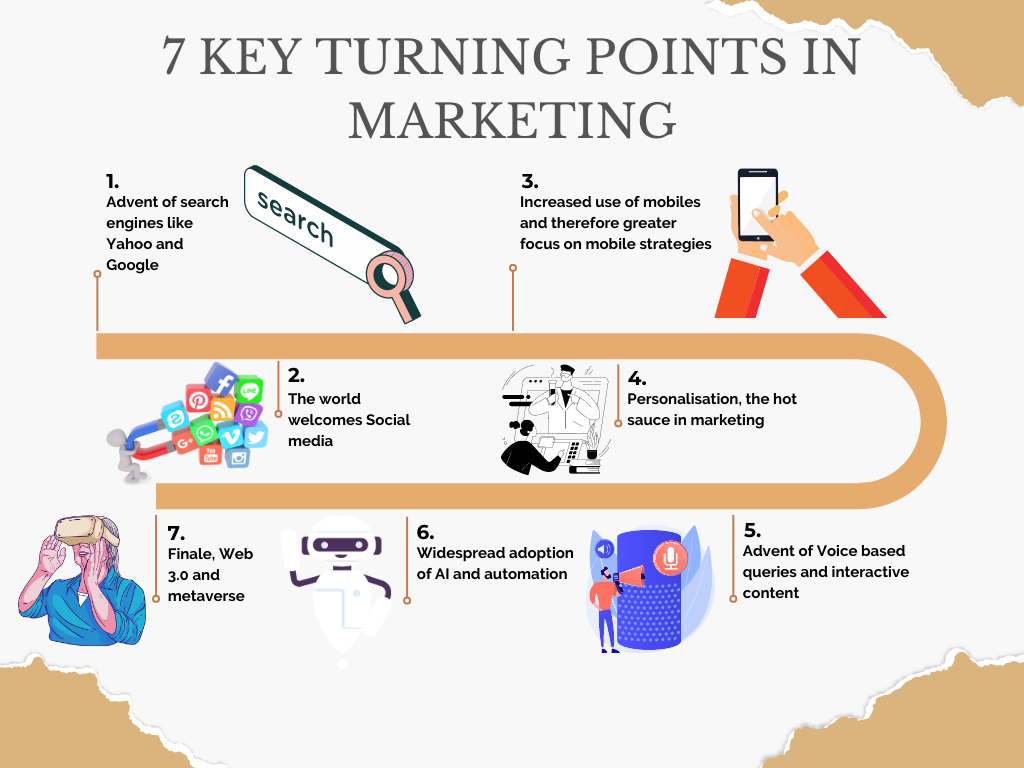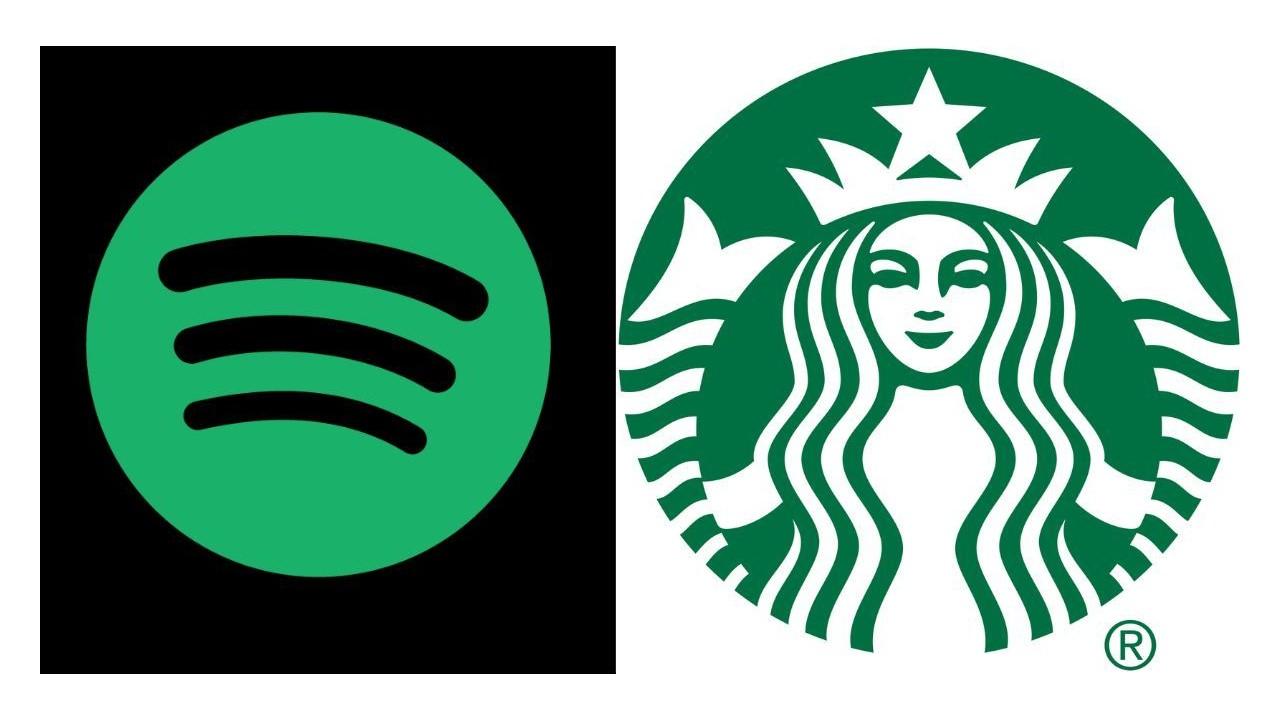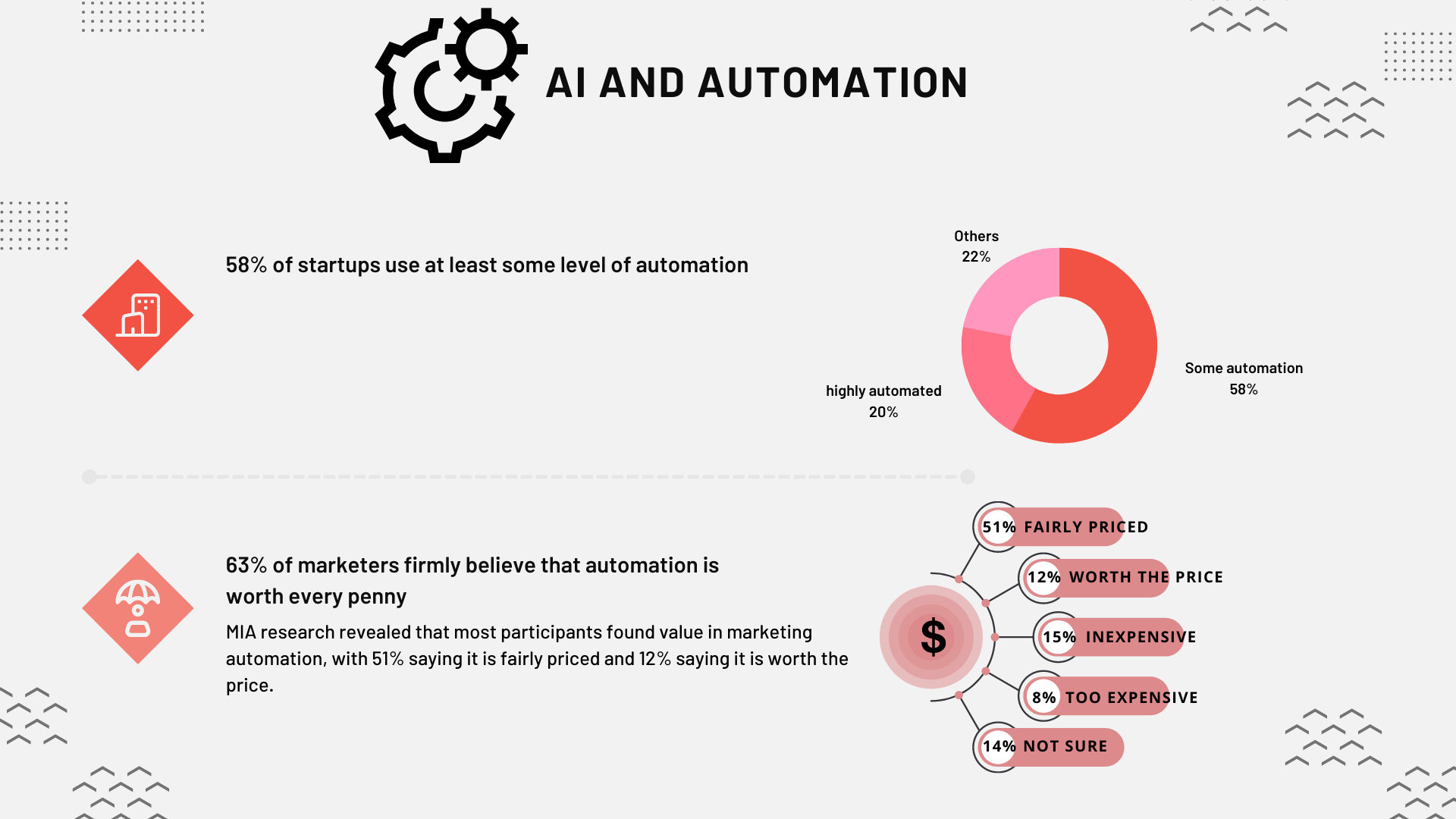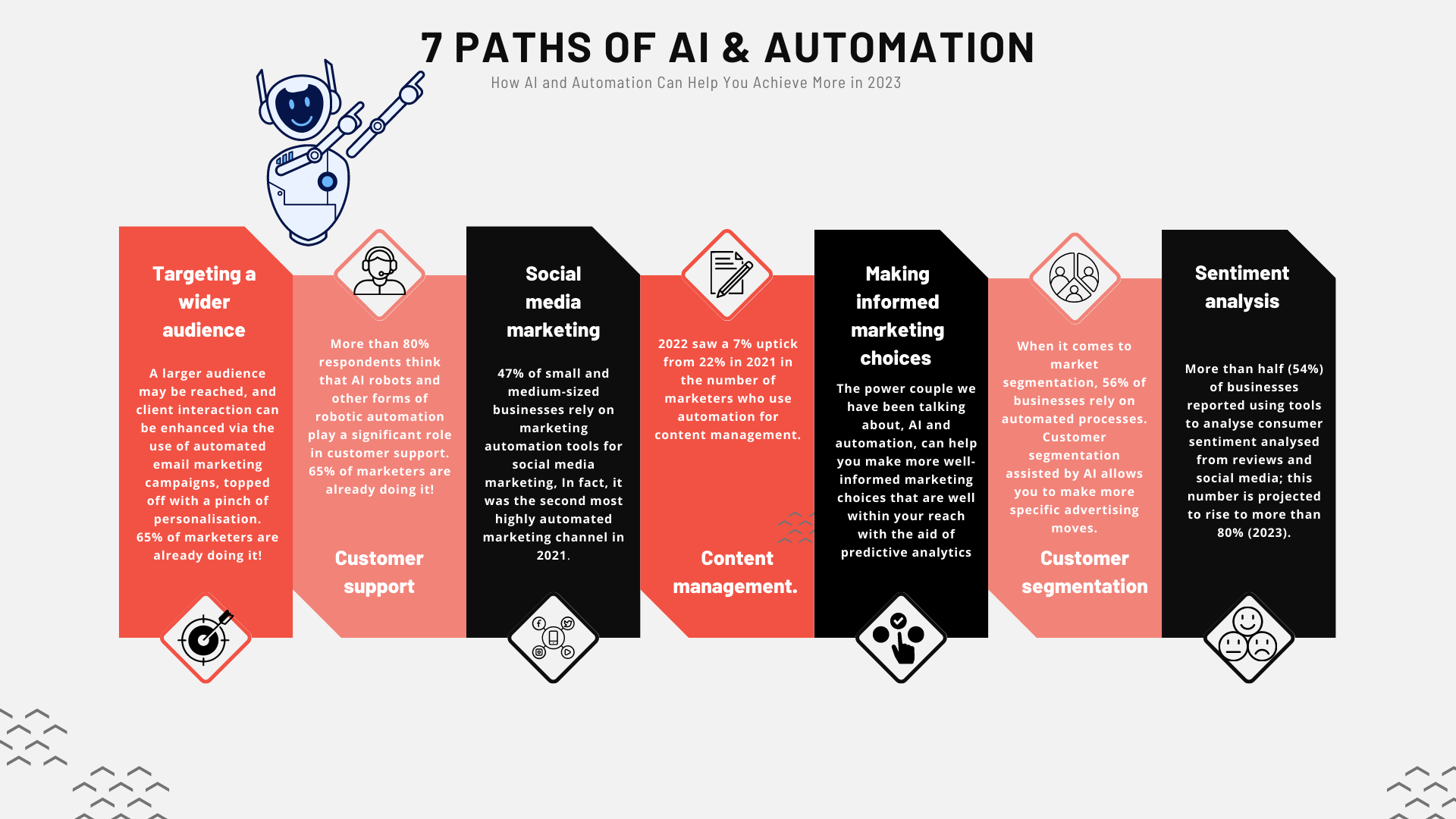How are you keeping up with the modern-day communication system? It is not very easy, right? I hear you, pal. One has to find means in order to move faster and more efficiently.
In the past, marketing campaigns were considered a one-time, single-goal means of communication for a company. However, now there is a plethora of almost everything. Even the channels of marketing. In order to be effective, whether as an individual or a company, you need to have multiple channels of communication with your customers and prospects. Just initiating the conversation and zeroing in on the right channels is a grim problem. But today, I am not here to discuss the difficulty of this problem but to address its evolution.
The mere fabrication of every being on this planet is the result of evolution, and we humans thrive on expectations. There are expectations from work, expectations at work, expectations from the surroundings, and expectations from the technology, and therefore, with every advancement in technology, our systems, strategies, and processes progress a little and evolve! However, let’s focus on the evolution of marketing channels from the use of posters in 1839 to the metaverse in 2023.
Definition of marketing channels with a brief history to get you started
If you are into public speaking or have ever tried your hand at it, you know the importance of a microphone, a loudspeaker, and the cord connecting the two. It’s the communication link between your audience and yourself. Now imagine if any one of them is missing. The link breaks!
A marketing channel serves a similar purpose for a business. It is any one of the several ways in which a company may interact with its target audience.
The marketing channels might be online, like social media and websites, or offline, like networking events and word of mouth. Just like you could be talking live at a gathering or you could be communicating via the web.
These channels could be through different media, such as TV commercials, radio advertisements, direct mailers for reaching out to potential clients, or online resources for customer service purposes.
There are four categories of marketing channels: paid, free, digital, and traditional. Digital marketing, also known as “digital communications” or “e-marketing,” is the use of the electronic medium to create and deliver marketing messages to target audiences. The use of search engine optimisation (SEO), paid search, blogs, emails, and videos all comprise digital channels. Digital media presents new ways for consumers to interact with a company’s brand and take action. Today’s consumers are using digital tools to “tune in” or “turn off” companies’ marketing messages as they please. This form of marketing is often mixed with traditional forms of media such as TV commercials, radio advertisements, and print.
Paid marketing channels are typically as follows: Paid search (Google sponsored ads and Bing sponsored ads) Display advertising (TV, newspaper, magazine, billboards) Pay-per-click advertising (search engines) AdWords bidding Sponsored stories on Facebook & Native ads.
Also recommended: Smart work or hard work ?
Free marketing channels, on the other hand, comprise of content marketing; email marketing, word-of-mouth networking, social media apps like LinkedIn, question-and-answer sites like Quora, and niche product discovery sites like Product Hunt are all examples of free marketing channels. Creating a comprehensive channel marketing plan and perfecting your techniques across all channels has many positive effects on a company’s bottom line, but more on that later. Let’s focus on the evolution part.
When people talk about evolution, our brain starts picturing a chronology. While that is one way of thinking about it, the chronology is merely a representation of data according to successive calendar years. When I think of evolution, my brain focuses on the events that shaped it.
The phrase “digital marketing” was coined in 1990. However, there are precisely 6 major events that resulted in its evolution, and the seventh is just around the corner.

- The advent of search engines. Although the World Wide Web (WWW) went live in 1991, it wasn’t until 1994 that the first widely used browser, Netscape, became available. In the late 1990s and early 2000s, as the number of people using the internet increased, the first versions of search engines like Google emerged. Web pages are indexed and stored by search engines so that they may be retrieved in response to specific keyword queries. Because of this, new fields of search engine marketing (SEM), search engine optimisation (SEO), and paid advertising emerged that involved boosting the online exposure of businesses.
- Welcome, social media! To begin with, the WWW was a place where people could work together to disseminate knowledge. However, it evolved into something far greater than that with Facebook, Twitter, and other social media sites that facilitated not just information sharing but also interpersonal relationships between users. This also helps companies access customers all around the world.
- Increased focus on mobile strategies. Next, you see, to keep up with Google’s Accelerated Mobile Pages (AMP) initiative, mobile sites should be optimised for search engines. This means reducing the amount of time it takes for websites to load on mobile devices. The most recent data on mobile phone use makes this a crucial point. Mobile devices (excluding tablets) accounted for over 55% of total internet traffic in January 2022, up significantly from 6% in 2019. With the proliferation of mobiles and the advent of the AMP initiative, it is now crucial that advertising campaigns not only work on desktop computers and laptops but also render correctly and behave as expected on smartphones, tablets, and other mobile devices.
- Fourthly, information on individual customers and personalised ads provided the next push. Because marketing techniques are always changing as a consequence of technological advancements and other reasons, the ability to forecast client behaviour is becoming increasingly important. As an illustration, consider customer relationship management (CRM), a business process that helps companies maintain meaningful connections with their clients over time using data-driven advertising strategies. Tools for customer relationship management allow for iterative work based on performance analytics data. Having this information can improve the ability to foresee client purchases, narrow down demographics, and satisfy customers more thoroughly. The use of data to develop specific advertising initiatives is another watershed moment in the development of digital marketing. It is feasible to detect shifts in consumer behaviour by employing customer relationship management tools like regression and statistical analysis.
- Voice-based queries and interactive content nudged the evolution further. Voice search is already an established part of the cutting edge technology. All thanks to the rise of digital assistants like Amazon’s Alexa and Apple’s Siri. Increasing client participation and building brand loyalty is a primary focus for many companies. This has resulted in the proliferation of innovative forms of media, including games, entertaining social media contests, absorbing app experiences, and more. They not only draw in viewers but also give you the means to keep them interested over the long haul. However, voice search has quickly become one of the most significant marketing trends, offering a novel approach to both consumer research and brand promotion.
- The sixth event would be the adoption of AI and automation. The AI market is on the boom. By 2027, it is expected that the global market for AI will be worth $407 billion, with a compound annual growth rate (CAGR) of 36.2% for the projection period. Gartner claims that companies that implement AI will see a 25% increase in consumer satisfaction by 2023. AI and automation are making it possible for businesses to analyse large amounts of data about their customers and create more personalised and relevant marketing messages. This allows businesses to deliver tailored content that is more likely to resonate with their target audience and drive engagement and magnify efficiency by outsourcing mind-numbing tasks to the machines thereby reducing the risk of human error.
- Finally, Web 3.0 and metaverses. Metaverse is now a reality, and we are slowly taking in the essence of Web 3.0. For the newbies here, the term “Web 3.0” refers to a theoretical upgrade to the current iteration of the World Wide Web. It’s the next step in letting people have complete say over their own work and other people’s digital assets and identities online. While the concept of the metaverse, a 3D immersive environment where we will spend a great deal of time interacting socially, professionally, recreationally, academically, etc., is not yet a reality, it is a goal the year 2023 shall work towards.
Will technology be really shaping the way we market?
Let me explain this with the example of storytelling. A good story is timeless. Irrespective of whether it was written a thousand years ago or yesterday. A good story is a good story, regardless of how it’s told. Yet the mediums and resources at our disposal keep evolving. There goes a saying that marketing has evolved from the description of the stuff you have made to the narrative with which you pitch it. The stronger the narrative, the higher is the probability of your marketing campaign hitting a home run.
In fact, the term “storytelling” itself has its roots in the transmission of narratives by visual means, such as cave paintings, before evolving into the more familiar “oral traditions,” in which tales were spoken and retold from one generation to the next. In light of this, I’d like to discuss how advancements in technology will shape the business of marketing in the years to come.
Even though the core message of marketing is timeless, the medium of communication keeps evolving. So, let’s say we begin with artificial intelligence (AI). Because AI improves both the existing tools we use and the ways in which we connect with those tools, I believe it will have a profound impact, especially on creative processes like storytelling but not limited to that.
Also read: The Complete Guide To Marketing Automation And How It Can Transform Your Business
Most artists and designers now days are seen hunched over a computer, tapping away at a keyboard and mouse. It’s challenging, you have to admit. It’s true that original thought requires a high level of training and experience, but maybe by the end of this century, we’ll have found better ways to share our thoughts with machines. You already have products like the Amazon Echo that enable voice control of home automation systems, but soon much more advanced options will be available too. Something like, you tell the program (machine) precisely what you want it to do, and it’ll handle all the grunt work for you.
That implies there will be fewer obstacles to overcome, lowering the barrier to entry into narratives using technology. This means that a commercial might be made by a person without any special training, or a film, a vlog, or anything else, without needing any specialised knowledge or training.
In any case, I believe it will open doors for many more individuals who are creative but may lack the required technical expertise. And this is just one specific case of storytelling.Technology is already shaping digital marketing through the evolution of digital marketing channels. We just have to patiently watch the magnitude of this transformation.
11 most crucial digital marketing channels
Just like there isn’t just one technique to promote a product, there isn’t just one channel either. There are a myriad of opportunities in the field of digital advertising. If the chosen marketing channel strikes the proper chord with the target demographic, whether it be SEO, SEM, social media, content, PR, or events, the marketer may truly make a difference.

SEM, social media, smartphone applications, and other platforms are all examples of digital marketing channels. Therefore, I’ll spare you the hassle and just go through the essentials you need to know as you formulate your plan of attack.
1. Social media marketing
Did you know that the concept of social media goes back to the 1940s? The concept of connecting computers through networks first appeared after their introduction in the 1940s. CompuServe, one of the earliest types of online access, was established in the late 1960s . In 1997, Andrew Weinreich launched the first formal social networking site, Six Degrees. However, in 2004 (with the launch of Facebook), Facebook paved the way for social media marketing.
In order to expand their customer base, increase sales, and strengthen existing relationships, businesses are increasingly turning to social media marketing strategies. And why shouldn’t they? I mean, have you seen the engagement on those channels? Social media marketing is a widely accepted marketing channel leveraged by all startups as well.

Well, if you’re still wondering if you really need an Instagram or Pinterest account, or a Twitter, Facebook, or LinkedIn account, you must know that social media platforms serve almost 60% of the world’s population and are therefore a vital part of your digital marketing strategy for creating consumer interactions since they are a place where your audience naturally expresses their opinions and sentiments. These platforms also promote fruitful interaction between brands and their consumers or future customers.
Having worked with various local and blue-chip clients, Emmanuel James, a marketing strategy expert and leader says,
Each social media platform attracts its own user base with a unique set of features and functions, and users have certain goals in mind when they log on, and that is precisely how you segment your user base. So if your target audience are people who like fashion, then Instagram would be a go-to channel as its visual nature makes it a favourite platform for people who enjoy looking at or posting fashion-related content.
You know, before the advent of social media, targeting a particular audience required a lot of hard work, research and sometimes, guesswork. But studying the audience behaviour in these social media platforms, along with data analysis and automation, has made life much easier. So understand which network your audience favours the most and hit the bull’s eye.
Emmanuel James – Marketing Strategy Expert
2. Search engine optimisation (SEO)

Before I talk about SEO, let me highlight its importance with just three simple statistics.
- Organic search referrals account for 53.3% of total website traffic.
- Combined, Google Search, Google Images, and Google Maps account for 92.96% of all traffic on the internet.
- More than half (60%) of the startups use SEO to drive traffic.
Now that you know the importance of ranking your content / website on Google, let’s talk further.
When done properly, SEO may raise a website’s visibility in organic search results. Which in turn can raise brand recognition, increase demand, and attract more targeted visitors. To succeed in organic search, you need to have a firm grasp of a wide range of advanced ideas. These include keyword research, backlinks, and the way Google’s algorithms handle page experience and trust signals.
One of the most challenging marketing strategies is SEO, or search engine optimisation. On the other hand, it’s the strongest marketing channel. Optimising for search engines allows you to connect with your target audience when they are actively seeking information. As a result, you may have maximum impact on your listeners at the precise moment they are receptive to your message. By optimising for search engines, your brand is visible at every stage of the customer’s journey, not just the beginning. This will increase your brand’s visibility and credibility while satisfying your customers’ needs.
SEO enthusiast and growth specialist, Amir Ariff has over 15 years of experience in developing and implementing solutions that maximise brand conversation. He says,
Think of SEO as a roadmap for your website’s journey to reach its ultimate destination: success. With comprehensive SEO strategies, you can guide your website along a path of increased traffic, conversions, leads, brand protection, market expansion, share gains, word-of-mouth, and online sales. It’s like having a GPS that ensures your website is always on the right track towards its goals and reaches its fullest potential. By continually updating and refining your SEO approach, you can ensure that your website stays ahead of the competition and reaches its target audience effectively.
Amir Ariff
Google claims that organic search yields a 5.3X ROI on average, whereas sponsored search yields just a 2X ROI. Not only that, but it’s also the only channel where value increases with time. All things considered, it’s easy to see why SEO is one of the most successful digital marketing channels for generating high returns on investment (ROI).
3 Pay-per-click advertising (PPC)
PPC advertising entails paying to have a website appear higher in a search engine’s organic search results (SERPs). Advertisers compete for a click using an auction system in paid digital channels. Campaigns, keywords, ad groups, ad messages, price bids, ad timing options (e.g., day of the week and time of day), and landing page creation are all common components of paid search strategies.
In situations where quick results are essential, paid advertising is a good marketing channel. Paid media campaigns may be initiated rapidly, in contrast to content marketing and SEO which might take many months to bear fruit. For this reason, PPC advertising is a viable alternative for limited-time promotions or brand-new product rollouts. In addition to its obvious utility for research, it also serves as a fast and easy way to validate hypotheses and theories. Companies reserve up to 10% of the paid media budget for PPC during the customer journey. Strategic use of PPC advertising alongside SEO is the key to getting your brand to the top of SERPs on Google and other search engines.
4. Content marketing
Let me begin by busting the biggest myth with respect to content marketing. That is, the content is business specific. No, my friend, it’s not!
What we call “content” now is a strong and multifaceted narrative medium. Not tied to any one industry, the term’s application is flexible.
Content marketers need to plan ahead and keep up with the current content marketing trends. The methods utilised to captivate clients and communicate the intended message are the same across sectors.
Simply put, “content marketing” refers to the process of generating and disseminating relevant material to a defined audience. In contrast to advertisements, which constantly barge into people’s lives in an effort to make a sale, content marketing consistently provides value to customers at every stage of the buying process.
A content marketing plan that’s been given some serious thought might reap significant rewards. It works well at all stages of the sales funnel (TOFU, MOFU, and BOFU). When you communicate with your audience with pertinent content, you give them a glimpse into the character of your business. You lay the groundwork for a lasting bond between yourself and the customer. Content is one-of-a-kind because it can be used to generate interest, stir up enthusiasm, and keep consumers enthusiastic about a company. Furthermore, SEO, email marketing, social media, and influencer marketing are all bolstered by the inclusion of high-quality content. As a consequence, marketing as a whole is improved, and each individual piece of content generates a greater return. Owing to its vast number of benefits, most businesses allocate up to 13% of their marketing budgets for content marketing. 30% of startups claim to use it to drive business.
5. Influencer marketing
The marketing of influencers is a lucrative industry, so much so that even startups cannot resist the temptation. Statista reports that by 2021, the value of the entire sector would reach about $14 billion. That is up 42% from the $9.7 billion predicted for 2020, with further growth to more than $16 billion expected by 2022.
For every $1 a brand invests in influencer marketing, it returns $5.78.
In its most fundamental form, influencer marketing occurs when a company gains credibility with an influential person’s audience by gaining the attention and endorsement of that person’s followers. In order to succeed as a brand, it is essential to earn the trust of your target demographic. However, consumers may be skeptical of the advertising they see on sponsored media platforms and other forms of digital marketing. In order to get over this difficulty, businesses might use influencer marketing. Getting your product or service into the hands of a trusted member of a certain group may do wonders for your brand’s reputation.
Let’s talk Dior for a bit, shall we?

Dior and the influencer marketing firm Buttermilk won the Best Beauty Campaign award at the 2020 Influencer Marketing Awards. The campaign aimed at promoting the introduction of Dior’s Forever Foundation, which comes in 67 different tones.
The goal of the campaign
Dior wanted to raise brand awareness of the new Dior Forever Foundation throughout the world by showing the many different colour options.
The strategy behind the success
A representative for each colour was also sought in an effort to highlight the product’s inclusiveness. The creation of branded material that could be used again on Dior’s owned channels was also a goal of the campaign. Buttermilk demanded very particular numbers and standards from its chosen influencers. Like superb levels of interest and participation and the ability to pass authenticity checks while sitting in prime positions for target markets (and also having audiences in these locations). Last but not least, the majority of the material they create for Dior’s channels will be influenced by beauty and cosmetics.
Plan in action
They settled on a total of 67 influencers to collaborate with. Each of whom represented one of Dior’s 67 colour offerings. In return, the influencers posted once a day for 67 days straight.
The impact
The total audience size for the 67 influencers was 2.66 million. Additionally, there were 1.85 million total impressions and 592 thousand total engagements with their postings.
6. Email marketing
Every year, there are thousands of marketers who secretly wonder, “Is email marketing dead?”
However, it is not.
In other words, email as a marketing channel is still very much alive. And the year 2023 will not diminish the efficacy of this marketing strategy. The most plausible reason for the failure of those email campaigns, however, is that so many companies are making basic blunders, like:
- Not appearing professional. The style and feel of your marketing emails should be consistent throughout and convey competence and reliability on the part of your company. In contrast, if your emails include typos, overuse stock photos, or have a sloppy layout, they may come off as unprofessional, if not fraudulent. (And that’s definitely not what you want.)
- Beginning on the Wrong Foot As the old adage goes, “you never get a second chance to make a first impression.” And since the welcome email serves as the customer’s introduction to your email marketing, it must be flawless.
- Losing Sight of Mobile Users. It’s estimated that 60% of all emails are opened on a mobile device. Your company might lose a lot of money if you don’t make your marketing emails accessible on mobile devices.
One of the simplest methods to reach people is through email marketing. Email marketing has a strong return on investment, on average generating $36 in profit for every $1 spent. As a result, email marketing is popular with 32% of the startups. Furthermore, email marketing allows you to communicate directly with your target audience and provides several opportunities for targeting certain subsets of that population. If you’re using email marketing, you may target your message to a specific demographic at a particular moment. Moreover, automation allows you to nurture your consumers over time, which deepens the relationship and promotes brand love.
7. Affiliate marketing
By 2022, affiliate marketing expenditures by U.S. businesses are expected to reach $8.2 billion. Now that I have your attention, let’s talk further.
If you are looking for digital marketing that is more affordable but just as effective, consider affiliate marketing. It can be a great way to gain new customers and make a profit at the same time. The key to success with affiliate marketing is really about offering quality content and differentiators that will help your customers.
Affiliate marketing is a type of digital marketing in which a business rewards one or more affiliates for each customer brought about by the affiliate’s own marketing efforts. This is a performance-based marketing strategy, where the affiliate is only paid when their marketing efforts lead to a sale or other desired outcome. This can be an effective way for a business to reach a wider audience and increase sales, as the affiliates are incentivised to promote the business and its products or services. Additionally, affiliate marketing can be a cost-effective way for a business to acquire new customers, as the business only pays for results and doesn’t have to invest in advertising upfront.
8. Partnership marketing
We are all people of reason. So let me first put forth the importance of a good partnership. 75% of global commerce is conducted through indirect means, therefore, channels, partnerships, and alliances have assumed a much greater significance.
Let us understand this symbiotic relationship with an example: the famous Starbucks and Spotify.

Co-branding Campaign: First-of-its-Kind Music Ecosystem
With the help of music, Starbucks was able to take its concept of a high-end coffee shop and grow it into a global powerhouse.
By working together under a shared brand name, Starbucks and Spotify have created a “music ecosystem” that will benefit both companies by exposing more music to Starbucks’ customer base and expanding Spotify’s massive music library, creating a partnership of mutual benefit.
To put it simply, a partnership marketing campaign is one in which two or more firms collaborate for the promotion of both of their brands. When engaging in partnership marketing, it is essential to choose associates whose offerings match your own.
9. Mobile marketing
Once again, let us turn to the data, shall we?
58% Market share for consumer gadgets is now held by mobile devices.
According to a recent study, 4.67 billion people around the world utilise mobile internet and an average of 24 hours per month is spent on the YouTube mobile app.
In order to reach consumers, businesses are increasingly turning to mobile marketing, and so should you. Recent data shows that mobile devices are rapidly taking over desktops and laptops. As a result, more and more individuals are turning to their mobile devices as their primary source of news and information. This implies that businesses should generate mobile optimised content. As the saying goes, ‘ignore at your own risk.’
10. Media buying
The market for media buying services is expected to grow from its current value of US$ 69 billion in 2022 to US$ 125.9 billion by the end of 2032, at a CAGR of 6.2%. In 2021, media buying services held a nearly 12% share of the global advertising market.
When it comes to purchasing smart media, it’s not just about paying money for advertising space. In fact, you can increase your reach while spending less on advertising with the aid of media buying teams.
Your marketing department can increase conversions and demonstrate to their clients and other stakeholders a significant return on investment. Using a knowledgeable team and method for media buying has many significant benefits.
How do you do it? Simple
- Finding the best deal with pricing, ad spaces, and strategic negotiations such as the average cost of leads or what brand exposure should cost is common knowledge for media procurement specialists.
- Get the best slots to place your advertisements that result in the highest levels of interaction.
- Use best practices when organising campaigns and employ tactics that will most effectively increase conversions.
Media buying is an effective digital marketing channel used by 55% of startups.
11. Events and awards
Before COVID toiled with our lives, participation in events and awards was a great way to socialise and market. But COVID turned the tables. The impact was so loud that only a handful (2%) of startups are looking at the events and awards as a branding medium.
You know what? It’s time to snap out of it because these corporate gatherings can help with digital marketing in a number of ways.
First, participating in events or winning awards can provide a sense of credibility and legitimacy for a business, which can help to build trust with potential customers.
Also read: Marketing Automation And Why Startups Need It
Secondly, events and awards can be a great way to network with other businesses and potential customers. Attending events or being a part of award ceremonies can provide opportunities for businesses to make connections and build relationships that can be valuable for their marketing efforts.
Thirdly, events and awards can be sources of content for digital marketing efforts. Businesses can share news about their participation in events or their wins at award ceremonies on their social media channels, which can help create buzz and attract attention from potential customers.
Finally, events and awards can provide opportunities for businesses to showcase their products or services to a wider audience. This can be especially valuable for businesses that are just starting out or looking to expand their customer base. By participating in events or winning awards, businesses can gain exposure and reach new potential customers.
How are AI-powered, automated marketing techniques are better for enhancing ROI?
Marketing has come a long way in the last few years. It has evolved from a one-way communication channel to a two-way dialogue. This is largely because of the advent of new technologies and innovations such as AI, automation, and personalisation.
Irrespective of whether you are directly involved with marketing or not, you are surely aware of the perks of automation and personalisation. Automation and personalisation are two marketing techniques that have become mainstream in recent years. These techniques are all about using data to deliver personalised messages to customers at scale, with the help of machines. Data shows that a majority of startups (58%) are using at least some level of automation, while 20% are using highly automated marketing strategies, with 100% of the latter coming from the funded group.

Despite its merits, automation faces its fair share of criticism, owing to the expense involved in installing the infrastructure. Nevertheless, 63% of marketers firmly believe that automation is worth every penny when weighed against the benefits it has to offer.
AI powered marketing, on the other hand, is all about using artificial intelligence for marketing purposes. It is a subset of automation and personalisation that uses machine learning algorithms for automating marketing tasks such as lead generation, lead qualification, and customer retention.
Also read: 3 Ways How A.I Is Redefining Customer Engagement
Akshay Kumar Sharma, a young entrepreneur who is the co-founder and CEO of Personate.ai, has been working closely on AI powered personalisation. Deriving from the experience he has gathered in the process, he shares
AI-powered, automated, and personalised marketing techniques are ensuring better ROI by allowing businesses to more effectively target their marketing efforts and deliver more personalised, relevant messages to potential customers.
With AI platforms such as Personate.ai, businesses can send personalised videos to their customers, that can speak their name, their demographics, interests, and behaviours, to provide a hyper-personalised customer experience. This allows businesses to create tailored, personalised marketing campaigns that boost conversions, create brand recall and enable businesses to build strong relationships with their customers. Data published by HubSpot shows that a personalised call to action results in 202% more conversions than one that isn’t. As per Forbes, 40% of CEOs confirm that personalisation increased sales, market size, and profit in direct-to-consumer channels.
Proving the ROI of marketing is one of the biggest hurdles faced by 41% of marketers. Therefore, using AI along with automation can help businesses create more effective marketing campaigns that are tailored to the specific needs and preferences of their target audience, which can result in a higher ROI. By leveraging these technologies, businesses can more effectively reach and engage with potential customers, ultimately driving more conversions and sales.
Akshay Kumar Sharma, Co-founder & CEO of Personate.ai
7 Ways AI and Automation Can Help You Achieve More in 2023

1. Want to target a wider audience? Use automation with email marketing because 65% of marketers are already doing it! A larger audience may be reached, and client interaction can be enhanced via the use of automated email marketing campaigns, topped off with a pinch of personalisation. Artificial intelligence will help you here. It can evaluate client data and help you write email messages that are more relevant to each individual. As a consequence, your marketing activities will be more efficient and provide greater results.
2. More than 80% think that AI robots and other forms of robotic automation play a significant role in customer support. Don’t lag behind.
According to Carl Gerathy, the founder of TAGR, an insights specialist who holds an experience of more than 20 years of working in different geographies,
Customers’ experiences and happiness may both benefit from the fast, individualised assistance that AI-powered chatbots can deliver. Chatbots are able to comprehend questions from customers and respond with pertinent, correct information in real-time, thanks to the use of natural language processing (NLP) and machine learning techniques. As a result, your support staff may have more time for more difficult cases.
Carl Gerathy, Founder TAGR
3. Already, 47% of small and medium-sized businesses rely on marketing automation tools for social media marketing. In fact, it is the second most highly automated marketing channel in 2021, with 47% of marketers reporting using social media automation.
Also read: Free Marketing Automation Tools That Are A Great Help To Marketer
Using automation software, social media marketing efforts are better managed and optimised. Using AI to sift through your social media account data, you can zero in on the posts that garner the best engagement and discover the best material to share with your audience
4. 2022 saw a 7% uptick from 22% in 2021 in the number of marketers who use automation for content management. But with AI infiltrating the content marketing domain, content writers are definitely concerned, and though it might not have been as easy as a walk in the park, the relationship between content writers and AI is gradually booming. Here’s why. Tools driven by artificial intelligence allow you to create high-quality, engaging content more rapidly and efficiently. These programs may scan data from your website, social media accounts, and other sources to come up with ideas for fresh content and even write rough drafts of articles or posts using NLP and machine learning algorithms.
5. The power couple we have been talking about, AI and automation, can help you make more well-informed marketing choices that are well within your reach with the aid of predictive analytics. Your marketing efforts can greatly benefit from AI analysis, as you can more easily spot patterns and trends that might help you forecast future outcomes and change your plan accordingly. You can improve efficiency in resource management and increase your return on investment by doing so.
6. When it comes to market segmentation, 56% of businesses rely on automated processes. Customer segmentation assisted by AI allows you to make more specific advertising moves. Customer data is further segmented into niches with shared traits using machine learning algorithms. This allows for more targeted marketing to groups based on their expected interests.
Moreover, through the use of AI, you can personalise the service you provide to each individual consumer. Customers are more likely respond to your recommendations, offers, and other information if you evaluate their purchasing habits prior to launching a campaign.
7. Finally, how would you feel if you could know how your customers felt about your brand?
It could be a revelation, right?
More than half (54%) of businesses reported using tools to analyse consumer sentiment analysed from reviews and social media; this number is projected to rise to more than 80% (2023).
Well, understanding how consumers feel about your brand is possible with the aid of sentiment analysis by analysing reviews, social media posts, and other forms of client feedback enabled by artificial intelligence.
Also read: MIA Research Stats: Will 2023 Need A Different Marketing Strategy?
Overall, the use of AI and automation in digital marketing helps businesses create more effective and efficient marketing campaigns, tailored to the specific needs and preferences of their target audience. This can help businesses reach and engage with potential customers in a more meaningful way, ultimately driving more conversions and sales, as well as providing transparency into the marketing process. Many digital marketers, bloggers, and e-commerce professionals believe that AI and automation will be game changer for their businesses in the near future. Simply put, the use of AI and automation in digital marketing is one of “the most significant change since the dawn of social media”. Therefore it is crucial to put it to use right away while there’s still time.
















